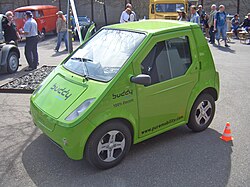This article relies largely or entirely on a single source .(August 2014) |
Kewet was the brand name of a battery electric vehicle. Since 2007, it has been manufactured under the name Buddy by Elbil Norge in Oslo, Norway. From inception in 1991 through October 2013, total combined sales of the Kewet and Buddy totaled approximately 1,500 units, mainly in Norway. [1] It is similar to the Citicar of the 1970s.
